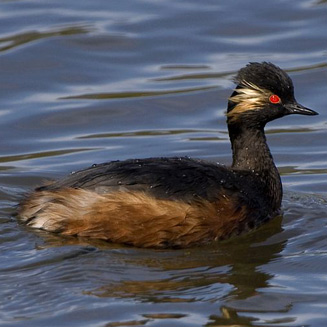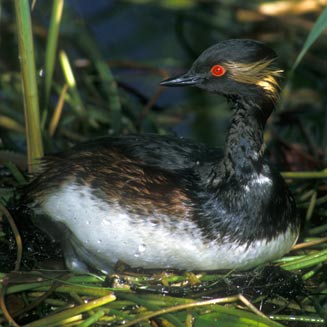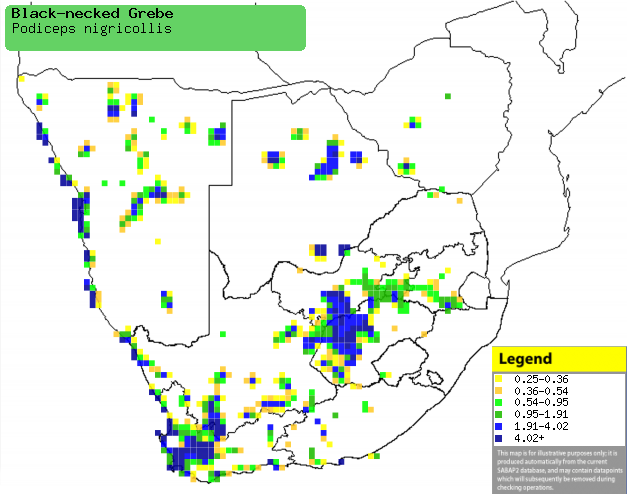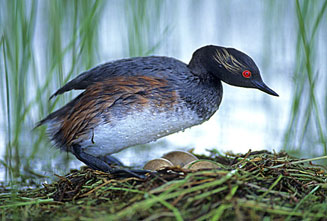|
Podiceps nigricollis (Black-necked
grebe)
Swartnekdobbertjie [Afrikaans]; Geoorde fuut [Dutch];
Grèbe à cou noir [French]; Schwarzhalstaucher [German];
Mergulhão-de-pescoço-preto [Portuguese]
Life
> Eukaryotes >
Opisthokonta
> Metazoa (animals) >
Bilateria >
Deuterostomia > Chordata >
Craniata > Vertebrata (vertebrates) > Gnathostomata (jawed
vertebrates) > Teleostomi (teleost fish) > Osteichthyes (bony fish) > Class:
Sarcopterygii (lobe-finned
fish) > Stegocephalia (terrestrial
vertebrates) > Tetrapoda
(four-legged vertebrates) > Reptiliomorpha > Amniota >
Reptilia (reptiles) >
Romeriida > Diapsida > Archosauromorpha > Archosauria >
Dinosauria
(dinosaurs) > Saurischia > Theropoda (bipedal predatory dinosaurs) >
Coelurosauria > Maniraptora > Aves
(birds) > Order: Ciconiiformes > Family: Podicipedidae
 |
 |
|
Black-necked grebe in breeding plumage, Paarl Bird
Sanctuary, South Africa. [photo
Trevor Hardaker ©] |
Black-necked grebe in breeding plumage.. [photo Peter Steyn
©] |
Distribution and habitat
Occurs across Eurasia, North and South America and
sub-Saharan Africa. In southern Africa, it
is uncommon to locally common in patches of Namibia, central Botswana, Zimbabwe
and South Africa, from the Western Cape to Gauteng and Mpumalanga. It generally
favours large pans and temporary water bodies, particularly those that form
after heavy rainfall, as well as natural and commercial saltpans.
|
 |
|
Distribution of Black-necked grebe in southern Africa,
based on statistical smoothing of the records from first SA Bird Atlas
Project (©
Animal Demography unit, University of
Cape Town; smoothing by Birgit Erni and Francesca Little). Colours range
from dark blue (most common) through to yellow (least common).
See here for the latest distribution
from the SABAP2. |
Movements and migrations
Nomadic in semi-arid and arid areas, moving in
search of temporary pans and breeding wherever conditions are
suitable.
Food
It eats a variety of aquatic prey caught underwater,
sometimes foraging in flocks of over 75 individuals. The following food items have been recorded
in its diet:
- fish
- aquatic insects
- larvae
- crustaceans
- molluscs
Breeding
- Monogamous and usually semi-colonial, performing a wide variety of
territorial and courtship displays.
- The nest (see image below) is built by both sexes in about a week, consisting of a mound of algae and other soft plant matter,
anchored on an underwater plant in open water.
 |
|
|
Black-necked grebe at its nest, Wakkerstroom,
South Africa. [photo
Warwick Tarboton ©] |
|
- Egg-laying season is almost year-round, peaking in November in the Western
Cape and from March-April elsewhere.
- It lays 1-7 eggs, which are incubated by both sexes for about 20-22
days.
- The chicks leave the nest immediately after hatching, and are fed and
carried on the backs of both parents.
Threats
Not threatened.
References
-
Hockey PAR, Dean WRJ and Ryan PG 2005. Roberts
- Birds of southern Africa, VIIth ed. The Trustees of the John Voelcker
Bird Book Fund, Cape Town.
|
